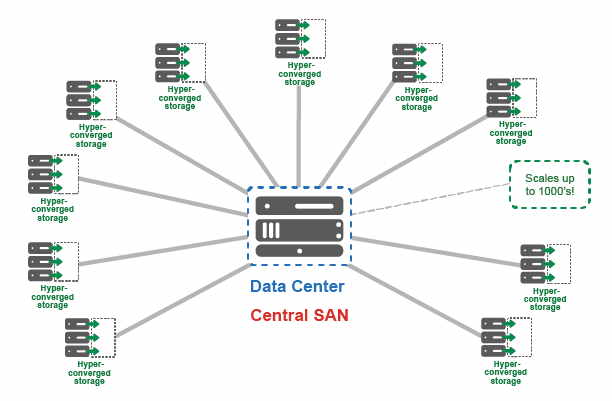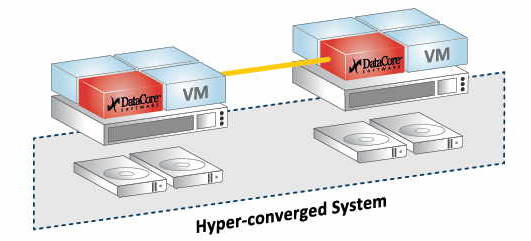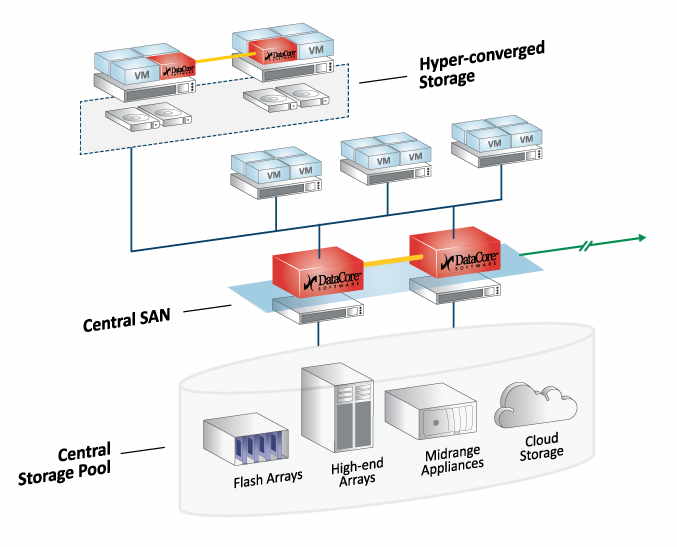New results of research conducted by Enteprise Management Associates (EMA).
The Industry Impact Brief makes note of several recent benchmarks results that independently quantify the economic and performance capability of parallel I/O technology. The first result referenced is firm’s world record for price performance ($0.08/SPC-1 IO/s) achieved with SANsymphony software-defined storage and Hyper-converged Virtual SAN software featuring Adaptive Parallel I/O technology. The company also recorded the fastest response time ever measured on the SPC-1 benchmark at that time with 0.32 milliseconds at 100% load (459,000 SPC-1 IO/s) on a hyper-converged system running on a compact off-the-shelf 2U Lenovo server, total costs were only $38,400 [i]. That’s 3x to 10x faster than competing systems that cost several hundreds to millions of dollars.
Newer results validated on software from the company use parallel I/O technology to enable compact, power and space saving 2U servers to utilize multicores to multiply server performance; firm’s parallel server elevated the numbers to 1.5 million SPC-1 IO/s, while setting a new record response time of 0.10 milliseconds at 100% load [ii]. The result of this is a decreased number of physical servers from five to one, offering savings in capital, software licensing, administrative effort, and environmental expense.
Detailed in a recently-published Industry Impact Brief, Jim Miller, senior analyst, EMA, states: “DataCore has been delivering significant cost savings with comprehensive storage services for heterogeneous environments long before the creation of the term software-defined storage. By putting multi-core servers to work using Adaptive Parallel I/O technology, DataCore has added a capability to save on capital and operational expenses for both storage and servers.”
The economic and productivity impact goes beyond the ‘consolidation’ boom that server virtualization started, but did not finish. More VMs running on the same CPU delivered the first wave of consolidation savings but on today’s multi-core systems with dozens to hundreds of CPU cores available, the potential for more savings is greatly multiplied. However as the number of CPU cores has grown, new performance issues have surfaced in virtualized environments as only a single CPU core is typically assigned by the hypervisor to process I/O operations – despite the abundance of CPU cores available. This restriction creates an ‘I/O gap’ between application processing and I/O processing, and when paired with the aggregation of mixed workloads, a bottleneck in performance arises.
The economic and productivity impact goes beyond the ‘consolidation’ boom that server virtualization started, but did not finish. More VMs running on the same CPU delivered the first wave of consolidation savings but on today’s multi-core systems with dozens to hundreds of CPU cores available, the potential for more savings is greatly multiplied. However as the number of CPU cores has grown, new performance issues have surfaced in virtualized environments as only a single CPU core is typically assigned by the hypervisor to process I/O operations – despite the abundance of CPU cores available. This restriction creates an ‘I/O gap’ between application processing and I/O processing, and when paired with the aggregation of mixed workloads, a bottleneck in performance arises.
Enterprise application workloads, and especially databases, achieved limited cost saving benefits since they had to resort to larger cluster complexes and utilize many more systems to overcome the ‘I/O gap’ and serial processing bottlenecks. Counter to consolidation, this led to more server sprawl to process these demanding business workloads.

Company’s Adaptive Parallel I/O software solves this problem by multiplying the performance of virtualized and hyper-converged systems by enabling the execution of many independent I/O streams simultaneously across multiple CPU cores, reducing the latency to service and process I/Os. Rather than serializing I/O as competing products do, parallel I/O software automatically allocates the number of core resources needed to eliminate the mismatch between computational and I/O processing. This reduces the I/O limitations and bottlenecks that restrict the number of VMs and workloads that can be consolidated on server and hyper-converged platforms. The impact of harnessing untapped multi-cores with parallel I/O software completely redefines performance and the economics of TCO; it enables the next wave of hyper-consolidation productivity that allows IT shops to ‘do far more with less’ and lower server and storage costs.
According to EMA, there are two primary benefits of parallel I/O software: it reduces the number of physical servers while achieving faster application response times using lower-cost, commodity-based storage hardware. This reduction in servers increases in importance as the market transitions from traditional enterprise storage (NAS, SAN, DAS) to enterprise server SAN storage, or hyper-converged systems. Next is the savings in storage costs. By treating the root cause of the problem, performance requirements can be met or exceeded with less costly storage resources. As a result, company’s Adaptive Parallel I/O software enables IT organizations to reclaim the savings of virtualization that had become diminished due to the I/O gap.
 |
| Hyper-converged System |

The Industry Impact Brief makes note of several recent benchmarks results that independently quantify the economic and performance capability of parallel I/O technology. The first result referenced is firm’s world record for price performance ($0.08/SPC-1 IO/s) achieved withSANsymphony software-defined storage and Hyper-converged Virtual SAN software featuring Adaptive Parallel I/O technology. The company also recorded the fastest response time ever measured on the SPC-1 benchmark at that time with 0.32 milliseconds at 100% load (459,000 SPC-1 IO/s) on a hyper-converged system running on a compact off-the-shelf 2U Lenovo server, total costs were only $38,400 [i]. That’s 3x to 10x faster than competing systems that cost several hundreds to millions of dollars.
Newer results validated on software from the company use parallel I/O technology to enable compact, power and space saving 2U servers to utilize multicores to multiply server performance; firm’s parallel server elevated the numbers to 1.5 million SPC-1 IO/s, while setting a new record response time of 0.10 milliseconds at 100% load [ii]. The result of this is a decreased number of physical servers from five to o
ne, offering savings in capital, software licensing, administrative effort, and environmental expense.
EMA stated that the company has long been known for delivering significant cost savings with comprehensive storage services for heterogeneous environments. Lenovo Co., Ltd, Fujitsu, Ltd.,Huawei Technologies Co., Ltd., and Dell Inc. currently offer solutions that include firm’s software with their servers. As Adaptive Parallel I/O technology gains traction, EMA believes that other server vendors will follow suit and offer the company’s software. Not to do so would put these vendors at a significant disadvantage.
ne, offering savings in capital, software licensing, administrative effort, and environmental expense.
EMA stated that the company has long been known for delivering significant cost savings with comprehensive storage services for heterogeneous environments. Lenovo Co., Ltd, Fujitsu, Ltd.,Huawei Technologies Co., Ltd., and Dell Inc. currently offer solutions that include firm’s software with their servers. As Adaptive Parallel I/O technology gains traction, EMA believes that other server vendors will follow suit and offer the company’s software. Not to do so would put these vendors at a significant disadvantage.
“EMA applauds DataCore for approaching the virtualized server performance problem in a new, more efficient way,” continued Miller. “DataCore was recently awarded Best Enterprise Solution for Software-Defined Storage in the recent EMA Radar Report for Enterprise Software-Defined Storage. For parallel I/O technology, DataCore currently has no competition.“
[i] SPC Benchmark 1 Full Disclosure Report DataCore Software Corporation DataCore SANsymphony-V 10.0 (Current as of 11/30/2015)
[ii] SPC Benchmark 1 Full Disclosure Report DataCore Software Corporation DataCore Parallel Server (Current as of 2/26/2016)
[ii] SPC Benchmark 1 Full Disclosure Report DataCore Software Corporation DataCore Parallel Server (Current as of 2/26/2016)
Read also:
While driving fastest response times ever reported
